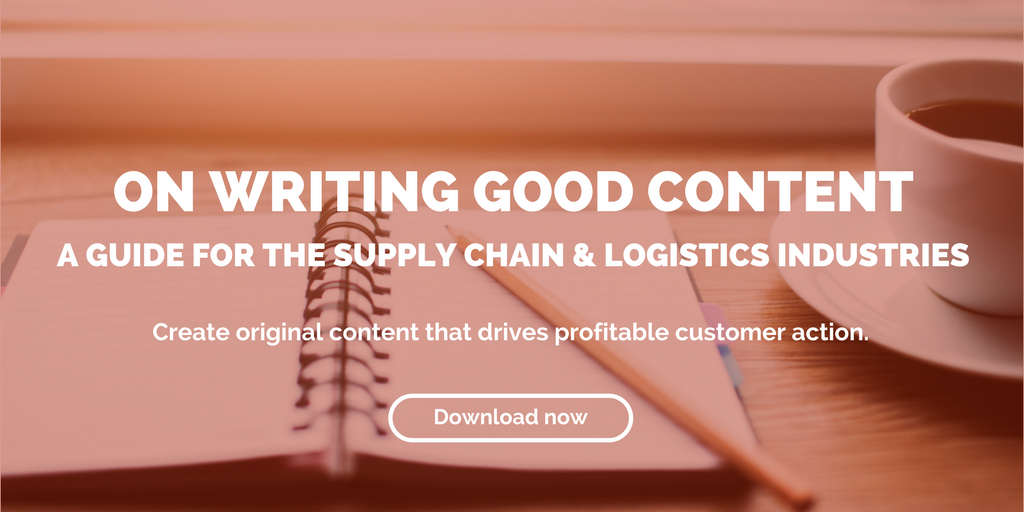
by Fronetics | Feb 13, 2018 | Blog, Content Marketing, Logistics, Marketing, Supply Chain
Here are three tips for writing pillar content that will help structure your posts, attract leads and gain better page rankings.
In case you missed our series on writing for SEO, pillar content is a highly effective way to define your brand, drive traffic, and convert website visitors to leads. But in order to be effective, these pages should be strategically designed to do their proper job in telling search engines what your site is all about.
Before we go further, let’s take a step back and talk about exactly what pillar content is. As search engines adjust their algorithms to favor topic-based content, savvy marketers are turning to topic clusters to structure their content.
“This method uses a single pillar page as the main hub of content for a given topic. All of your content assets related to that topic link back to the pillar page,” explains HubSpot blogger Amanda Zantal-Wiener.
Need some ideas for writing and structuring effective pillar content? Here are three tips to get you started.
3 tips for writing pillar content
1) Start thinking about your site differently.
Not so long ago, SEO optimization was all about keywords. But search engines are changing. As their algorithms get more sophisticated, they look for websites that can provide depth and breadth on a particular topic. That means topic-based content wins you better page rank. It’s time to start thinking about your site as a collection of topics rather than a collection of keywords.
2) Consider your core audience.
“Think about the top interests and challenges of your core audience personas to give you ideas for pillar page content,” says HubSpot blogger Sophia Bernazzani.
Good content marketing is all about cultivating your reputation as a trusted resource for your audience, and pillar pages are no exception. Chose topics that answer the needs of your target audience. Topics should be broad enough to be able to generate multiple related blog posts, but narrow enough that you can cover all related content on a single pillar page.
3) Your content is about answering questions.
“Pillar pages should answer any question or query a searcher might have about a topic — which will make them want to click on your pillar page when they enter a Google search term that your page ranks for,” writes Bernazzani. The goal is to draw site visitors with savvy pillar content, and let them explore all content in your topic cluster.
Related posts:


by Fronetics | Jan 23, 2018 | Blog, Content Marketing, Marketing
Measuring the success of your content is important in evaluating your writing for SEO strategy. Here’s how to do that.
This week, we’re wrapping up our series on writing for SEO. In this series, we’ve explored how search engines are changing, how people are changing the way they search, and how to make use of topic clusters and pillar content. Now, with a better understanding of the changing SEO landscape, it’s time to think about how to measure the success of your content.
As with any marketing effort, having a documented strategy for your content’s search engine performance — and a plan for measuring the success of your strategy — is key. You might be asking yourself, “How do I measure the success of a piece of content?”
Should I measure the success of one post at a time?
When it comes to SEO, the answer to this question can be complicated, largely because it’s not a great idea to evaluate the success of your campaign on a post-by-post basis. It’s too narrow a definition of success to account for the complex network of direct and indirect benefits of effective SEO writing.
Take brand-driven content, for example. Your focus isn’t about generating individual sales, but rather about elevating your brand, raising wider awareness, attracting new talent, or generating backlinks. If you based the success of brand-driven content on the number leads it generated alone, you’d think it was performing terribly. But your post may, in fact, have generated hundreds of backlinks and be getting lots of traffic.
Evaluating by cluster topic
So how do you evaluate success? Rather than looking at your content on a post-by-post basis, consider how all the content under each cluster topic performs as a whole.
According to HubSpot, “Measuring the entire topic cluster against all of your core business metrics will enable you to include residual benefits coming from content that doesn’t align with direct conversion goals.”
As you look at the performance of your topic clusters, consider the following four questions:
- Which topics perform best at driving traffic to your website or other web presence?
- Which topics earn you the most leads?
- Which topics drive the most revenue for your business?
- Which topics earn the most backlinks/coverage?
It’s important to remember that at the end of the day, what you’re working toward — and what will work best for your search visibility — is creating content that people want to see. Writing for SEO is ultimately about creating better content, increasing search engine visibility, and providing the best possible experience for your site visitors.
Related posts:


by Fronetics | Jan 17, 2018 | Blog, Content Marketing, Current Events, Marketing, Social Media
Users will see less content from businesses, brands, and media, so you need to adjust your strategy to appear on your followers’ Facebook News Feed.
Mark Zuckerberg once again rocked the world on January 11 — at least for businesses — when he announced that Facebook News Feed was evolving to include less public content, meaning content from Pages of businesses, brands, and media. The algorithm will now prioritize posts from friends and family (over public posts) and those that “spark conversations and meaningful interactions between people.”
Cue businesses around the world freaking out. They’re about to see their organic reach, video watch time, and referral traffic take a nose dive.
The fact is, this is really not a huge surprise. Facebook has been taking steps in this direction for a while, including the testing of Explore Feed last year. Even though you may have anticipated that some changes to Facebook for businesses were coming, you may be tempted to suddenly stop maintaining your Facebook Page. Is it worth posting content to Facebook if it is not going to reach your followers after these new changes?
Our stance at Fronetics is that Facebook is still worthwhile for businesses. But Zuck’s recent announcement does merit your close attention to — and perhaps a revisiting of — your Facebook strategy. We’ve compiled a list of things you need to know/do in light of the new changes to Facebook News Feed. Here they are.
4 steps to adjust your strategy for Facebook News Feed changes
1) Focus on news-worthy content that drives engagement.
Zuckerberg says, “I’m changing the goal I give our product teams from focusing on helping you find relevant content to helping you have more meaningful social interactions.” That means that engagement will now mean more than ever before for content visibility.
In other words, posting your blog content to Facebook is no longer going to cut it. If your posts don’t garner comments or reactions, it’s time to go back to the drawing board. You’ll need to start thinking of Facebook as a place to post and discuss active news items, hot-button issues, and highly shareable content (content that is educational or entertaining, for example).
Scheduling multiple posts ahead of time, though convenient, will probably land your content further into the depths of oblivion. You’re going to have to pay attention, actively seek to generate conversation between users with your posts, and fight to win space on your followers’ feeds.
2) Tell your community to access the See First feature.
Users who still want to see posts from certain Pages they follow can choose “See First” in News Feed Preferences. So, quite simply, we suggest asking your followers to choose to see your content.
While some proactive followers may do this on their own, we want to encourage you to explicitly remind your community to do this. Remember that people are most likely to do what you want them to when you make it easy, exact, and clear. So send them an email with directions. Or put it in your newsletter or a blog post. Just tell them to do it.
One thing you don’t want to do: goad people into commenting on your posts as a means to increase your content visibility. Facebook has explicitly stated that it will demote “engagement bait,” or posts that ask for comments or reactions. So you’ll actually hurt your content by doing this.
3) Get your executives on social media.
I’ve written before about getting your executives on social media as themselves — they act as brand ambassadors for your business. Facebook’s latest announcement underscores the importance of this directive.
Your company’s executives are the most visible people in your business. For many of your industry peers and customers, they are the face of your brand. Get them active on Facebook to add meaningful thoughts to your company’s posted content, to engage in discussions, and to share newsworthy content of their own.
It’s important to note that I don’t mean that they should do this in a superficial way. They should actively seek to add value to your Facebook content and that which is relevant to happenings within your industry. By being engaging on Facebook, your executives emerge as thought leaders, which boosts your brand’s visibility and reputation.
4) Consider your Ad budget.
In the past, we have recommended adding some social media advertising to a traditional content marketing strategy as a way for clients to add gasoline to a fire, so to speak. It speeds things up. But those companies who are just starting out or who rely heavily on referral traffic might want to consider reallocating budget to sponsored ads.
Final thoughts on the new Facebook News Feed
This is a shift, yes. A challenge, for sure. But not one that’s insurmountable — or even contrary to the basic principles of good, data-driven content marketing.
Remember, Facebook is not eliminating Page content from News Feed altogether — just limiting it. The most relevant, engaging Page content will win that space. So seek to understand your target audience and produce high-quality, original content that engages those people, and you’ll come out on top of the new Facebook News Feed.
Related posts:

SaveSave
SaveSave

by Fronetics | Nov 20, 2017 | Blog, Content Marketing, Marketing, Social Media
Measuring brand awareness has been notoriously difficult. But these 4 metrics can help you evaluate if potential customers are encountering your content.
Companies work hard to get their products and services out into the world. It’s a key step in gaining exposure among potential customers and earning new business. This process is called brand awareness, the extent to which consumers are familiar with your brand.
Heightening the public’s knowledge of your business will generate leads, some of which will turn into sales. But this knowledge, or brand awareness, has proven difficult to measure. Do potential customers know your name, what you sell, and where to contact you? Creating ways to measure how recognizable your business is will show you what people think of your company, as well as where you should be focusing your time and money to help grow your exposure.
Here are 4 metrics to measure your brand awareness.
1. Social media reach
The larger your social media reach, the larger the potential audience. The reach of your social media content has a big impact on your brand awareness. Tracking engagements on each network will help you measure progress, build a greater following, and, ultimately, generate more site visits.
Use tools like Sharedcount, a free online tool that tracks the number of times a piece of content has been shared on the most popular social media sites — including Facebook, Twitter and LinkedIn — to easily keep track of your social reach.
2. Blog shares
Your blog content is the perfect fodder for organic brand awareness, especially if sharing your posts is easy. Create a share bar on your blog to allow your readers to quickly share your content through social media networks. Measure your number of shares to track your most popular blogs, monitor your growing brand awareness, and help guide the topics of your future blog posts.
3. Brand mentions
Are customers talking about your brand online? There’s a great deal of value in knowing what they’re saying. Monitoring brand mentions online can provide honest feedback and objective insight from current and potential customers.
There are several tools to help you track brand mentions online. Here at Fronetics, we prefer the ease of Google Alerts, which allows you to set up custom alerts when your brand is mentioned online. We also use Hootsuite, where you can track brand mentions, as well as keywords and phrases across all of your social media platforms.
4. Website traffic
Every visit to your website represents someone who is familiar with your brand. The question is: How are people finding your website? Think of web traffic in terms of sources:
- Organic traffic – users come across your website from search engines
- Direct traffic – users type in the name of your website or brand directly
- Referral traffic – users find your website from links on other websites
- Social traffic – users come across your website from social media content
- Paid search/social – users click on one of your paid digital ads, which drives them to your site
- Email traffic – users click through one of your marketing emails
You’ll want a healthy balance of each source to ensure your brand awareness campaign is diversified. Measure each of these metrics using a platform like Google Analytics or HubSpot. As each grows, you’ll know your brand awareness is growing alongside.
Use these 4 metrics to measure your brand awareness and track your progress as you work to grow your exposure. See where you’re having the most success and where you need improvement, and adjust your strategy accordingly.
Related posts:


by Fronetics | Nov 6, 2017 | Blog, Content Marketing, Marketing
Use these four tips to earn high-quality backlinks that will boost your company’s search engine ranking.
It’s no secret that backlinks can help your search engine rankings. Backlinks are any link on another website that points (or links) back to your website. Since the 1990s, search engines have used backlinks as a bit of a popularity contest: the more you had, the more popular your website became.
It didn’t take long for companies to hunt for backlinks, creating relationships with other companies in the same industry for the sole benefit of getting links to their websites. But like all relationships, link building can be abused and, often times, only beneficial to one party. Pursuing links for search engine ranking alone creates a negative mindset, leading to uneasy relationships, damaged brand reputation, and low-quality, spammy links.
How can you achieve high-quality backlinks?
Let’s start by understanding what constitutes a high-quality backlink. SEO consultant Mark Walters defines them as links that:
- Are from a relevant and trusted source
- Have anchor text that matches your keywords
- Are on a page with Google’s PageRank
- Are next to backlinks to authority websites
- Are from different sources
- Are not reciprocal
- Are on pages with few other backlinks
Now that you know what defines a high-quality backlink, how can your company achieve these organic relationships? The answer is hard work.
Here are 4 tips to help your efforts get high-quality backlinks.
1. Create the best content available on your topic
The best content is content that is unique. Not only is original content SEO friendly, original content is audience friendly. In one minute, users share 300 hours of video on YouTube and tweet nearly 400,000 tweets times. If you want content that stands out, you need content that differs from that of the rest of the pack.
You can make content stand out by using winning headlines, graphics, images, and with great writing. Create every single piece of content with your current and prospective customers in mind. Content that attracts and engages audiences effectively communicates valuable information, providing knowledge to help guide informed decisions. Creating reliable information will establish your website and business as a thought leader within your industry, and other companies will start to take notice.
2. Perform exclusive interviews with industry experts and/or influencers
The strategy of interviewing industry experts is becoming more and more common. Here at Fronetics we often interview influencers. The draw from big names helps bring in new traffic to our site, as well as provide readers with the latest happenings in our industry.
“The benefits of creating content around authority figures in your space is vast, such as bringing recognizable authority names to your site, while also having the opportunity for such content to be shared by featured experts as well. The end result could create lots of great content for your site, while also bringing in a nice consistent supply of new traffic as well.” Writes Zac Johnson for Business 2 Community.
3. Create custom infographics
Images are a fail-safe way to create engaging content, but infographics do more than just give readers visual knowledge. Infographics also help achieve backlinks. They provide interesting and valuable information using images, giving readers the knowledge without having to read through heavy text. The most popular infographics incorporate amazing design and well-researched statistics.
According to HubSpot, social media users share and like infographics 3x more than other any other type of content. Good infographics have the ability to make your content go viral, generate tons of high-quality back-links, and improve your site’s overall SEO.
4. Participate in collaborative content marketing
Collaborative content has many benefits, but one of the biggest is reach. Your collaborators have their own followers and platforms. Combine that with your audiences, and your content is already reaching more people. These collaborations save time and money and will earn you backlinks through the other participants. Collaborative content will help drive organic traffic, provide valuable and relevant information, and introduce a new voice to your content.
Using these four strategies will help your company earn high-quality backlinks and start improving your search enginge ranking. Your higher rankings will come from organic backlinks that your hard work helped to create.
Related posts:









